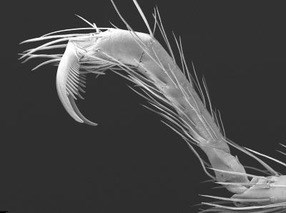Last updated: September 20, 2022
Article
Trogloraptor

Charles Griswold
Recent Discovery
Legends of giant spiders haunting your spelunking dreams? As it turns out, there might be some truth to the fiction. Trogloraptor marchingtoni, the only described species in its genus and family (Trogloraptoridae), is believed to be a relict within the six-eyed spider superfamily Dyxderoidea, and thus far has only been found deep inside of caves in Oregon (with the exception of one juvenile spider found in the debris of old growth redwood forests in California). This juvenile, however, is likely a new species of Trogloraptor, awaiting discovery of the adult stage.Trogloraptor means “cave robber,” in reference to its hook-like tarsi (last segments on their legs), which are likely used to capture flying insects straight out of the air.General Description
This yellow-brown spider has a body length of 7–10 mm and a maximum leg span of 7.6 cm. Its abdomen is purple-brown. The flexible hooked tarsi mentioned above is a very rare trait amongst spiders, found in only a few. Another unusual aspect of this spider: it has two rows of teeth! The last unusual Trogloraptor trait, marking it as a primitive spider, is that it only has two simple trachea on each side of its body, as opposed to its closest living relative, the goblin spider (Oonopidae), which has hundreds of tubes.
Charles Griswold
Ecology
Trogloraptor webs are but a few strands hung from the roofs of caves. Griswold, lead author of the first study on Trogloraptor, believes that they probably hang upside down on their webs, similar to the Nelson cave spider of New Zealand (Spelungula cavernicola), and snatch their prey out of the air. However, what exactly they consume is unknown. In captivity, researchers offered their Trogloraptors moths, crickets, and other spiders as food, but the spiders starved after two weeks, suggesting that they prefer something specific that we do not yet know. Human blood…? Unlikely! While it does have venom glands, there is no evidence showing that Trogloraptor venom is harmful to humans. Rather, the spider seems quite stage shy and scuttles away when it finds itself in the spotlight of flashlights.Where Found in the Klamath Network
Trogloraptor lives in Oregon Caves National Monument and Preserve. Given the discovery of the undescribed juvenile in the understory duff of the old growth redwoods, there also might be populations in Redwood National and State Parks.Fun Facts
- The specific name, marchingtoni, was given to the spider in honor of amateur cave biologist and Deschutes County deputy sheriff Neil Marchington, one of the original discoverers of the spider.
- Don’t think seven centimeters is big? They’re probably more surprising when they’re hanging from the ceiling on just a few strands of silk above your head, backlit by your headlight.
- Griswold reckons that the spiders might have had a bigger range fifteen million years ago, with the redwood forests also extending further east than they do today. But when the forests shrunk, so did the habitat of Trogloraptor, and the species might have then retreated into caves.
References and Further Reading
Griswold, C. E., T. Audisio, and J. M. Ledford. 2012. An extraordinary new family of spiders from caves in the Pacific Northwest (Araneae, Trogloraptoridae, new family). Zookeys 215: 77–102.
https://www.pbs.org/newshour/science/this-picture-shows-the
Download a pdf of this article
Prepared by Vi Nguyen
NPS Klamath Inventory & Monitoring Network
Southern Oregon University
1250 Siskiyou Blvd
Ashland, OR 97520
Featured Creature Edition: August 2015
